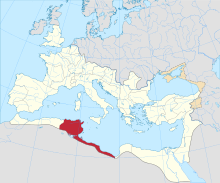Semta (Africa)

Semta was a Roman era Municipium also known as Augustum Semta in Africa Proconsularis that is tentatively identified with ruins at Henchir Zemba (Dzemda) [1] Carthage, Tunisia near the Oued el Kebir 20 km (12 mi) southwest of Zaghouan[2] at 36.269282, 9.887345.[3]
Ruins[edit]
The site has been excavated and those excavations revealed three different building complexes:[4]
- a 40 m × 50 m (130 ft × 160 ft) rectangular building,
- a 4 m (13 ft) high mausoleum and,
- two further buildings, one of which is called the Byzantine fortress, measuring 40 m × 30 m (131 ft × 98 ft).
Numerous inscriptions have been found there.[5]
Bishopric[edit]
The ancient city was also the seat of an ancient bishopric[6] in the ecclesiastical province of Carthage.[7][8][9] Only two bishops are known from Semta. The Catholic Maggiorino attended the Council of Carthage (411), as at that time the city had no Donatist bishops. Florenzio took part in the anti-Monothelite Council of Carthage (646). The current bishop is Juan Gómez.[10][11]
References[edit]
- ^ Brent D. Shaw, Sacred Violence: African Christians and Sectarian Hatred in the Age of Augustine (Cambridge University Press, 2011 ).
- ^ Barington Altas.
- ^ "Semta, Henchir-Dzemda – Digital Atlas of the Roman Empire".
- ^ Semta, Henchir Dzemda.
- ^ Louis Poinssot & Robert Lantier, Q. Geminius Sabinus, Princeps peregrinorum Comptes rendus des séances de l'Académie des Inscriptions et Belles-Lettres (1923) Vol 67, Num 3 pp. 197-201.
- ^ Semta at catholic-hierarchy.org.
- ^ "Apostolische Nachfolge – Titularsitze". Archived from the original on 2019-01-19. Retrieved 2016-12-21.
- ^ Semta at gcatholic.org (English)
- ^ J. Mesnage, L'Afrique chrétienne, (Paris, 1912), p. 63.
- ^ Le Petit Episcopologe, Issue 127.
- ^ Revue des Ordinations Épiscopales, Issue 1955, Number 71.
